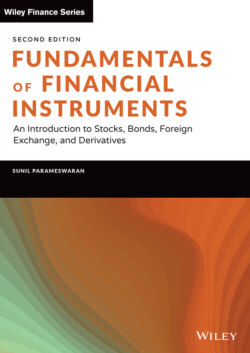Читать книгу Fundamentals of Financial Instruments - Sunil K. Parameswaran - Страница 53
На сайте Литреса книга снята с продажи.
THE INTERNATIONAL BOND MARKET
ОглавлениеThe international bond market provides borrowers with a source of medium- to long-term funds. Borrowers include multinational corporations, domestic corporations, governments, national, and supranational financial institutions. It gives investors in the debt markets a way to diversify their portfolios over several different currencies. We have already highlighted the wisdom of not putting all one's eggs in one basket. But it is not necessary that all the securities chosen should be from the same country. Transnational diversification enables investors to take the diversification process a step further. The market consists of two broad segments: Eurobonds and Foreign Bonds.
Eurobonds are bonds denominated in one or more currencies other than the currency of the country in which they are sold. For example, bonds denominated in a currency other than the Japanese yen that are sold in Japan would be called Eurobonds.
A bond denominated in the currency of the country in which it is sold, but issued by an entity from a foreign country, is called a foreign bond. For example, if a US company were to sell yen-denominated bonds in Japan, it would be classified as a foreign bond.
Thus, bonds may be classified into three categories: domestic bonds, foreign bonds, and Eurobonds. If Sony were to issue yen-denominated bonds in Japan, it would be categorized as a domestic bond, for the issuer and the currency of issue are local. But if IBM were to issue yen-denominated bonds in Japan, it would come under the category of a foreign bond. This is because although the currency is local, the issuer is from a foreign country. Finally, if either IBM or Sony were to issue US dollar–denominated bonds in Japan, it would be categorized as a Eurobond issue, because the currency is foreign. In this case, the nationality of the issuer is irrelevant.
Foreign bonds are known by nicknames. Bonds sold in the United States are called Yankee bonds; those sold in Japan are called Samurai bonds; and those sold in the United Kingdom are called Bulldog bonds.
The Eurobond market has grown much more rapidly than the foreign bond market. This is due to several reasons.
Eurobond issues are not subject to the regulations of the country in whose currency they are denominated. Consequently, they can be brought to the market quickly and with less disclosure. This gives the issuer of the bonds greater flexibility to take advantage of favorable market conditions. Consider a bond issue from the issuers' perspective. The greater the regulations, the greater the time lag between planning and implementation; thus there is a greater chance of missing favorable market conditions. Consequently, issuers, and the investment banks that advise them, prefer markets characterized by minimal regulations. On the other hand, domestic securities issues are regulated by the market regulator of the country. In the United States it is the Securities and Exchange Commission (SEC).
The origin of the Eurobond market was fueled by the imposition of a tax called the Interest Equalization Tax, which was imposed by the US government in 1963 on the interest received by American investors from Yankee bonds. What had happened was that due to the interest rate ceiling in the United States, domestic institutions were unable to pay a high rate of interest to investors. Foreigners sought to take advantage of this situation by issuing Yankee bonds with relatively higher rates of return. The objective of the Interest Equalization Tax was to ensure that American investors did not perceive Yankee bonds to be attractive, despite their higher interest rates. The motivation for this measure was to arrest the perceived flight of capital from the United States. As a consequence, foreigners were forced to relocate their dollar borrowings to outside the United States.
Eurobonds offer favorable tax status. They are usually issued in bearer form, that is, the name and address of the owner are not mentioned on the bond certificate. There are two broad categories of securities: registered securities and bearer securities. In the case of the first category a record is maintained of the owners at any point in time, by an entity known as a registrar or share transfer agent. Each time the security is transferred from one investor to another, the records are updated; however, in the case of bearer securities, physical possession is the sole evidence of ownership. These securities are like currency notes. If one were to drop a hundred dollar bill on the floor, it is impossible to prove that it belongs to us. Such securities are easier to transfer and offer investors the potential freedom to avoid and evade taxes. Thus, holders who desire anonymity can receive interest payments from such securities without revealing their identity. Also, interest on Eurobonds is generally not subject to withholding taxes, or tax deduction at source.
Because of their unique features, investors are willing to accept a lower yield from Eurobonds than from other securities of comparable risk, but which lack the favorable tax status.
Eurobonds are not usually registered with any particular regulatory agency but are, however, listed on a stock exchange, typically London or Luxembourg. Listing is done not so much for the purpose of facilitating trading, but to circumvent restrictions imposed on certain institutional investors like pension funds, which are prohibited from purchasing unlisted securities. Most of the trading in Eurobonds takes place OTC.
